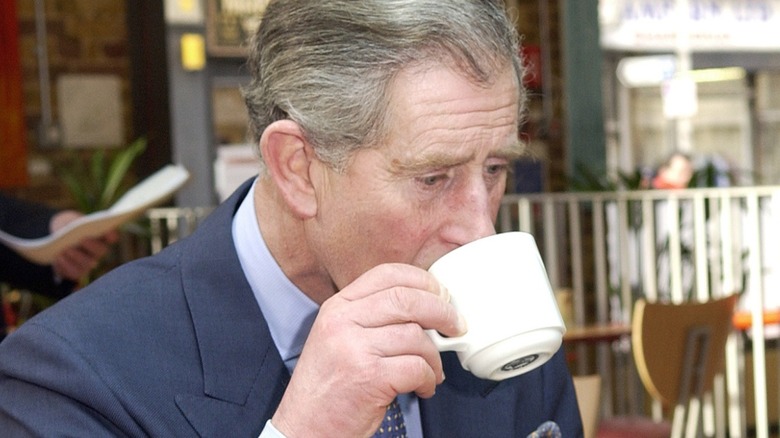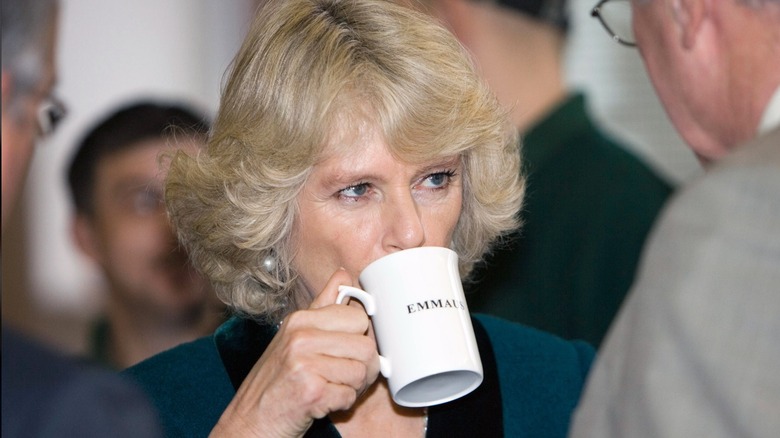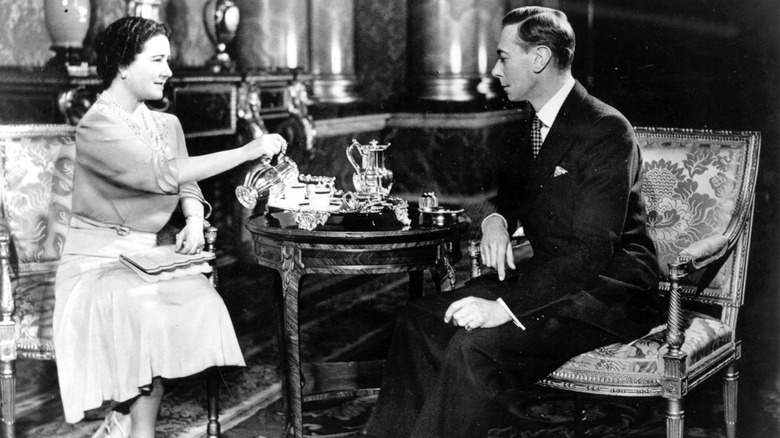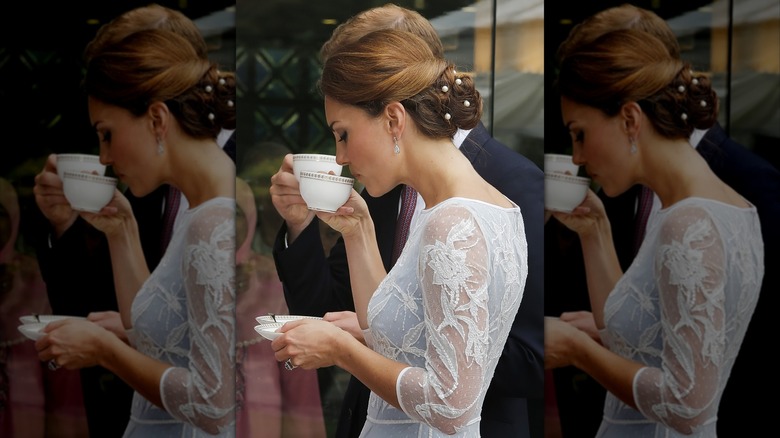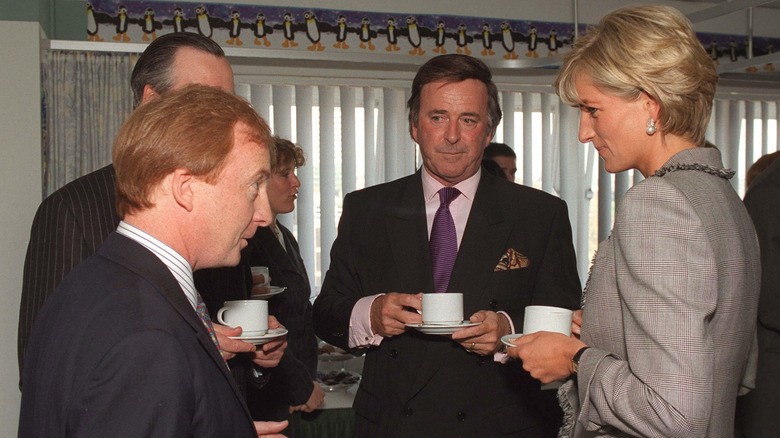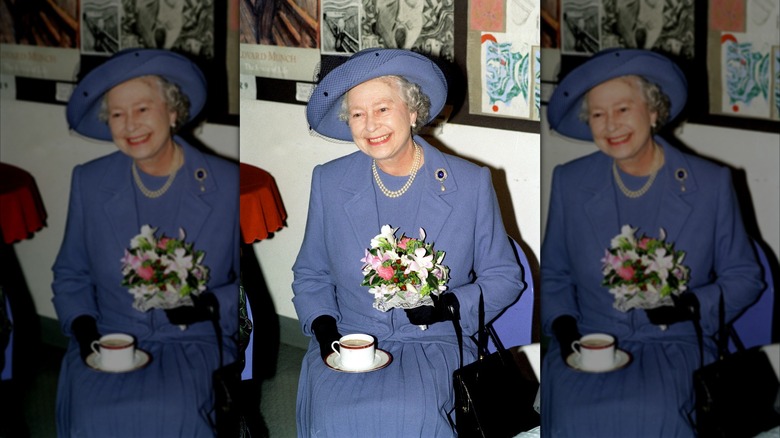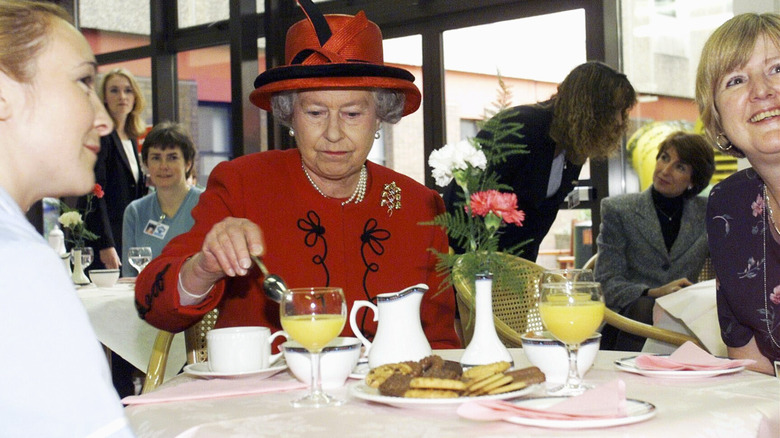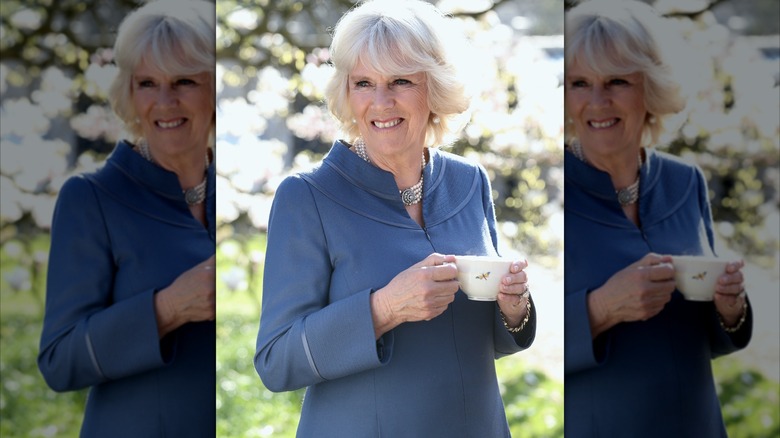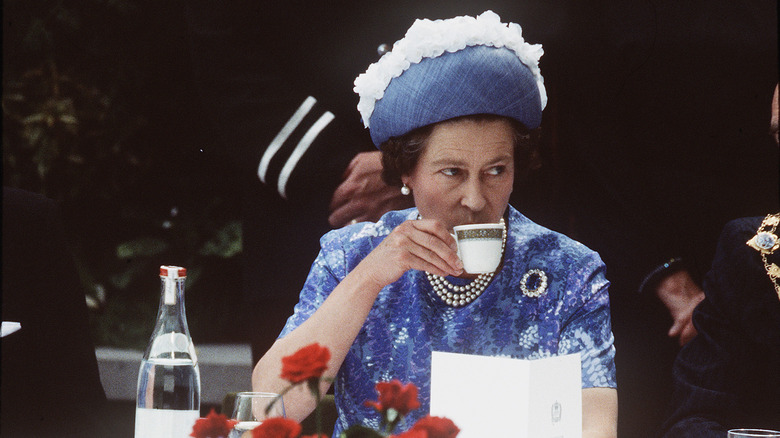Weird Rules Royals Have To Follow With Tea
We may receive a commission on purchases made from links.
Royals have to follow some unusual routines for just about everything — from the weird rules they follow at garden parties to even the way they go to the bathroom – so it should come as no surprise that the way they participate in the British tradition of an afternoon tea is subject to guidelines the average person probably doesn't consider before downing a cup of the warm, soothing beverage. In other words, you're not going to see a royal popping a K-cup in a Keurig for a quick spot of tea or drinking it out of a souvenir mouse ear mug from Disney World. No, the royals observe protocol in everything, even when it may seem strange or unnecessary to anyone else.
Before we get into some of the strange rules the royals follow at tea time, it's important to note that while tea may be consumed any time of day, the tradition of afternoon tea with all the trimmings is steeped in history. It is believed that Anna, the seventh Duchess of Bedford, introduced the concept to England in the year 1840 as a way to satisfy her afternoon hunger pangs. She regularly requested that a tray of tea, along with bread and butter, be brought to her room between lunch and dinner, and the idea caught on among her social circle. By the 1880's afternoon tea served with scones, clotted cream, and finger sandwiches became a regular occurrence among high-society women in England, who turned out in their finery for the occasion.
When setting tea, it's six and three
Table settings can get complicated, especially at fancy royal banquets or dinners. There can be several additional pieces of silverware other than the usual fork, knife, and spoon, along with multiple glassware and dishes. Afternoon tea is a simpler affair — but only slightly. Not to be confused with high tea, which is held later in the evening and is often served with heavier or more savory fare, afternoon tea is traditionally served with lighter bites and perhaps something sweet. That means that each place setting will need a small plate, along with a fork, knife, and the tea cup and saucer.
According to British etiquette expert and former butler to King Charles III Grant Harrold, there is specific place for each of these items. On an episode of his YouTube series, "At Home with The Royal Butler," Harrold explained the proper afternoon tea set up, including the very specific rules regarding the tea cup and saucer. First and foremost, any pattern on the china must be facing in the correct direction. Next, the tea cup must be placed on the saucer with the handle facing 3 o'clock. Finally, the spoon is laid on the saucer to the right of the cup, and pointing toward 6 o'clock. The saucer should always remain on the table while drinking tea. The only exception to that rule is if a royal must stand or move about, in which case it is acceptable to hold the saucer in the hand.
Add cream after tea to avoid a royal gaffe
The only disagreement in England bigger than Prince Harry and Prince William's feud is whether milk comes before or after the tea. You might think that this is a matter of personal preference, and it might be, unless you are a royal. While this may be more of a guideline, the late Queen Elizabeth II and the rest of the royals pour tea first and then add in milk, former royal butler Grant Harrold revealed (via Mirror). However, this tradition didn't begin with Elizabeth — and it actually has nothing to do with flavor profile, and everything to do with social standing.
The history of this practice may date back to Queen Victoria's reign when the servants used clay cups that would crack when hot tea was poured into them. Adding milk first cooled the tea just enough to protect the cup from breaking. The royals, on the other hand, used only bone china, which could withstand high temperatures without damage. Therefore, pouring the milk after the tea became a status symbol, indicating that one could afford fine china.
Although it may be a sign of privilege, practically speaking, adding tea before milk doesn't make much sense. Speaking on the chemistry of tea, Professor Andrea Sella from University College London, told Daily Mail that the milk-first approach makes for a smoother, less bitter taste. '"The proteins in the milk clump together with the tannins, making a black tea much more easy to drink," he said.
Pinch instead of clench the cup
On a cold winter day, it can be soothing to wrap your hands around a warm mug of tea, but that would be a royal no-no. Royals do not lift a tea cup by placing both hands around the base, nor do they loop a finger through the handle. Instead, as etiquette expert William Hanson told Marie Claire, protocol dictates that a royal must delicately pinch the handle with the thumb and forefinger, while the remaining three fingers help support by gently resting along the handle. To avoid any inadvertent spills and sloshes, they must also look down into the cup with each sip, royal manners and etiquette expert Laura Windsor confirmed to Reader's Digest.
What you won't see at an afternoon tea at the palace (or any time for that matter) is a royal pinky finger held aloft. Contrary to popular belief, sipping tea with the pinky out is not a sign of royalty. So why do people do it? According to Miss Manners, aka Judith Martin, it originated as a matter of necessity that dated back to the 17th century when tea cups had no handles. "Anyone with any sense kept as few fingers as possible on the (yeow!) hot cup," she wrote in the Chicago Tribune. Over the years it has become synonymous with arrogance and has become a comical illustration of snobbery. A true sign of class, however, is to keep the demurely pinky tucked in with the other fingers so as not to draw attention to oneself.
Don't cause a stir with your spoon
While some members of the royal family, like the Duke and Duchess of Sussex, are good at stirring up tea for the tabloids, you will never see a royal causing a stir while drinking it. Rather than give their tea a hearty swirl, the royals mix milk and/or sugar into their tea by making a small, 6 to 12 o'clock movement with their spoons. "You're supposed to do a very gentle back and forward motion," etiquette expert and former royal butler Grant Harrold explained in a demonstration for Hello! magazine. He should know. Harrold has served several King Charles III, the late Queen Elizabeth II, and the Prince and Princess of Wales, to name just a few. In the video, he explained the reason that a clockwise or counter-clockwise motion is frowned upon. "Because if you do that, you're going to make noise and it's going to go everywhere," he said.
In keeping with that whole "tea should be seen and not heard," thing, tapping the teaspoon on the edge of the cup is taboo. Instead, royals gently shake the spoon over the cup before placing it back on the saucer to the right of the cup. It should never touch the tablecloth, lest it leave a tea stain on the linens. If that sounds like a lot of trouble to go to for a cup of tea, one can avoid the whole potentially messy situation by simply drinking the tea without any add-ins.
Sipping must be done on the same side
One of the most unusual rules a royal must follow when it comes to sipping tea is that they must sip from the same spot on the rim every time, etiquette expert William Hanson told Marie Claire. This rule was designed with the female members of the monarchy in mind as a way to avoid leaving unsightly lipstick stains all around the cup. However, given some of the beauty rules that royals are forced to follow, one might not think that would be a big problem. Other than the late Queen Elizabeth II, who wore a signature pink shade, the other royal women stick to lighter, more natural shades. While the Princess of Wales has been caught breaking royal fashion rules, you probably won't see her sporting a bold red lip for this reason.
The teacups aren't the only area where royals must be mindful of leaving a mess. It goes without saying that the royals don't do paper napkins at afternoon tea (or most likely any meal for that matter) and no one wants to see lipstick or food stains on a white linen cloth. To avoid that issue, royals must fold their napkins in half and use the area inside the fold to dab at their mouths. Not only does this keep messes out of sight, it has the added benefit of preventing any stains from transferring off of the napkin and onto a royal lap.
There is an order to eating at afternoon tea
Afternoon tea isn't just about enjoying a warm brew. There are plenty of small bites that are part of the ritual, including scones, finger sandwiches, and small sweets typically arranged on a tiered cake stand. And while there are plenty of things that the late Queen Elizabeth II was never allowed to do in her life, planning her afternoon tea menu wasn't one of them.
According to former royal chef Darren McGrady, the menu for the royal afternoon tea was always run by the monarch first, and she made any changes she saw fit. "The Queen had a menu called a Menu Royale, a red leather bound book which she had each day," McGrady said in an interview with Coffee Friend. He explained that the book contained the suggested menus for the day's lunch, tea, and dinner, and that the tea always consisted of two types of sandwiches, scones, and cake, with the queen's favorite being a chocolate biscuit variety.
With so many goodies on display, it can be hard to know what to try first. But, just like one works from the outside in on silverware, it is customary to work from top to bottom on the tower of tea fare. The top tier, usually sandwiches, should be enjoyed first, followed by a scone from the middle tier, and finally a sweet treat from the lower level. Interestingly, McGrady said the chefs between Buckingham Palace and Balmoral always checked in with one another to make sure the queen was never served the same scone two days in a row. "I'm not sure what would have happened if we did," he said, "but we always checked."
Posture is paramount at tea time
While not technically a formal affair for a royal, sitting down to afternoon tea does demand a certain level of decorum in both dress and manners. You're not going to see King Charles III come in from a polo match and promptly take a seat at the table. There are certain royal rules regarding how to dress for the occasion which include slacks, a collard shirt, and jacket for men, and a dress for women. No jeans or loungewear will do, regardless of current fashion trends. Once seated, the napkin is placed in the royal lap with the crease facing toward the table, according to etiquette expert William Hanson told Marie Claire. When exiting the table, the napkin is not laid in the chair as some mistakenly believe but rather placed neatly to the left of the plate.
Throughout the tea, or any meal for that matter, royals sit up straight in the middle of the chair. No slouching against a chair back, rocking back in a chair, or, heaven forbid, leaning forward with elbows on the table. In fact, elbows should not jut out like chicken wings, but rather be kept close to the body. Talking with food in their mouths, chewing with their mouths open, and other normal breaches of table etiquette are also strictly forbidden. And, just like the teaspoon clang is frowned upon, so is any scraping of cutlery across a plate. Fortunately, most tea foods are eaten with the fingers so that helps to eliminates the issue.
When the monarch is through, you are too
The royals know that when the head of the monarchy has enjoyed his or her last sip, so has everyone else. Even if the Princess of Wales hasn't poured a cup, or the Duke of Sussex hasn't had his first scone, tea time is over, and everyone is expected to return to his or her royal duties. However, that doesn't mean one should rush through the afternoon tea. It is a ritual that should be enjoyed, and few enjoyed it more than the late Queen Elizabeth II, whether she was home alone or on the royal yacht.
"The Queen had afternoon tea every day, wherever she was in the world," former royal chef Darren McGrady said in an interview with Coffee Friend. "The Queen loved afternoon tea, I would say it's probably one of her favourite meals. Certainly when I was there, she would sit down religiously for tea."
It's a tradition that her son, King Charles III, and his wife, Queen Camilla, still observe, according to Camilla's son, food writer Tom Parker Bowles. "It's of primary importance," he told People. He added that today's monarchs like a little more sustenance with their brew. "It's not just a cup of tea — it's an entire meal. There are sandwiches, two different kinds of cake, scones, biscuits, shrimp and eggs." In October 2024, Parker Bowles even penned the cookbook "Cooking and the Crown: Royal Recipes from Queen Victoria to King Charles III," in which he shares an inside look at tea and other royal culinary traditions.
